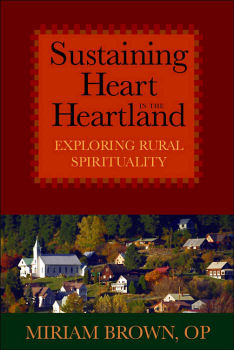
|
Posted October 6, 2005
Book: Sustaining Heart in the Heartland: Exploring Rural Spirituality Edited by Miriam Brown, OP Paulist Press, New York, pp. 183 An Excerpt from the Jacket:
Part One describes characteristics and themes of rural spirituality, as well as its hopes and struggles. Part Two examines ten “pieces” in the quilt of relationships that make up rural life – land, families, rural congregations, family farming, alternative movements, grassroots organizations, local communities, institutions, youth, and health ministries – with practical pastoral suggestions for each. Part Three provides three versions of expanding identities of local congregations. The book concludes with an open letter to the rural community, a lectionary of the seasons, and heart-sustaining prayers and rituals. An Excerpt from the book: A New Moment in Rural Communities Whether facing agricultural diminishment, land take-over, urbanization, or cultural diversity, rural communities face questions of identity and spirit. The challenge of sustainability – social, economic, environmental, spiritual – is placed before them. Now more than ever there is a call to participate not only in healing, but in creating vision and spirit. What will sustain the hearts of the people in this changing time? How eill they, in the words of Scripture, “choose life”? How does the community, discouraged by systems and trends outside their control and fatigued by personal efforts to survive, hold together and cross over into renewed life? An Extension Agent in a county-seat town of some size was working with community leaders on vision-making. He invited a church person to talk with them about “The Soul of Community Leadership.” The speaker placed their local task and decisions within the framework of the world’s challenges of sustainability, interdependence, dignity, hope, and justice. “It is a critical moment,” she said. “As leaders you are called to engage the journey as you structure relationships for the future. Around your planning tables you must consider the hearts and souls of your people. Given the direction of society for progress regardless of cost, the widespread disconnectedness from the land, and the challenge of engaging people to work for the common good, leaders like you have the unique responsibility/opportunity/call to frame your questions and make whole-community plans in terms of wisdom – soul.” These are deep spiritual challenges in this seemingly “dark night” in the community. It is a time of “exile.” Some will hear it as a call to begin again. It takes great souls to recommit to one another, as the people of the Exodus did, moving through the desert to the river’s edge where they “paused” before the unknown land before them. What deep commitments will be needed for today’s rural communities to cross over and create new places of promise? People will do the work of renewal in their own ways. It is not about a great leader coming in from the outside to take on a single issue, or about risking all for the cause. Rural community members work on what they are in – their groups, organizations, businesses, government – looking for ways to adjust for new times and coordinate with others toward new goals. Grassroots newsletters are filled with creative new ventures combining the talents of once separate entities. Always and foremost they maintain family, work, outreach, church, and public life, nurturing change within these areas. They bring this personal experience into the work of the whole. Individuals who take on their own growth challenges are able to understand and invest in the welfare of others. Part One Rural Spirituality 1. Interconnectedness of the rural heart 2. Rural spirituality 3. Themes in rural spirituality 4. Hearing the hurting heart of rural America Part Two The Heartland: Vibrant quilt of relationships 1. The land 2. Families 3. Rural congregations 4. Family farming 5. Alternative movements 6. Grassroots organizations 7. Local communities 8. Institutions 9. Youth 10. Health ministries Part Three Dimensions of Church life 1. The grace of it 2. Dying and rising 3. Churches involved 4. Pastoral review Epilogue |
|
